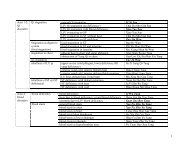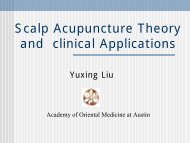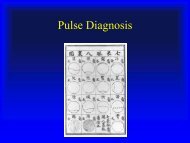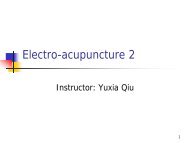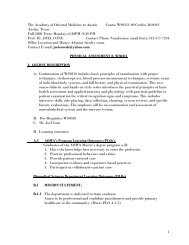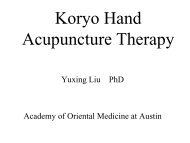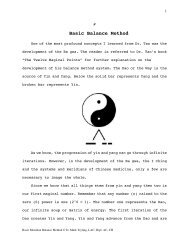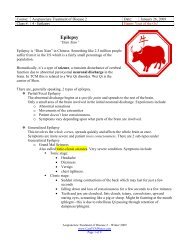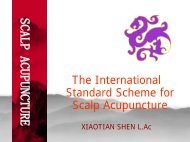Intro to Herbs - Class 4.pdf - CatsTCMNotes
Intro to Herbs - Class 4.pdf - CatsTCMNotes
Intro to Herbs - Class 4.pdf - CatsTCMNotes
You also want an ePaper? Increase the reach of your titles
YUMPU automatically turns print PDFs into web optimized ePapers that Google loves.
Course: <strong>Intro</strong> <strong>to</strong> Chinese <strong>Herbs</strong> Date: May 11, 2007<strong>Class</strong> #: 4<strong>Herbs</strong> As Guides To ChannelsDifferent herbs can serve as guides <strong>to</strong> different channels. Symp<strong>to</strong>m locations often indicate whatchannel is affected by a syndrome or disease. You can then use specific herbs <strong>to</strong> direct the formula <strong>to</strong> thechannel needing assistance for greater effect.One herb can go <strong>to</strong> different channels and also there may be multiple herbs that go <strong>to</strong> a given channel.Example: Herb X may remove wind while Herb Y relieves heat, but both may go <strong>to</strong> the same channel.Chuan xiong and chai hu for example, both guide <strong>to</strong> the shaoyang channel (gallbladder and san jiao).Here’s another example:Sheng ma is in the category of “expel wind-heat.” It guides <strong>to</strong> the yangming channel which is related <strong>to</strong>the S<strong>to</strong>mach and Large Intestine channels. When you use sheng ma as a guide <strong>to</strong> the channel you use asmaller dose than you would if you were using it for other functions.So basically, you create an herb team <strong>to</strong> perform the desired functions.How <strong>to</strong> Pair <strong>Herbs</strong> UpLook at Zheng Zeng’s handout and see the section called “Techniques for Combining <strong>Herbs</strong>.” It’s onpage 4 if you’re using the one on <strong>CatsTCMNotes</strong>.com. You need <strong>to</strong> know these, but you don’t need <strong>to</strong>know the Chinese term for them, just the English.It’s a lot more common in herbal therapies (whether they are Eastern or Western) <strong>to</strong> find single herbuses. Usually herbs are combined <strong>to</strong> better effect.Mutual AccentuationThis is also called Mutual Necessity. This is a combination of 2 substances in the same categorywith similar function. This is better than using only one herb and accentuates the therapeuticfunction.Example:Shi gao (30g) + zhi mu(15g) for a <strong>to</strong>tal of 45g. This combination controls fever andlowers body temperature. Shi gao controls fever quickly, but also wears off quickly. Zhimu does the same, but takes longer <strong>to</strong> work. The upside is that zhi mu lasts longer. Thisway you get a quick and sustained effect.Other happy unions:Da huang + mang xiaoQian xie + mu gongJing jie + fang fengMa huang + gui zhiHuang lian + huang qinHuang qi + shan yao<strong>Intro</strong>duction <strong>to</strong> Chinese <strong>Herbs</strong> – Spring 2007www.<strong>CatsTCMNotes</strong>.comPage 1 of 4
Mutual EnhancementAlso called Mutual Employment. This is a combination of 2+ substances in different categoriesand similar function. Together they give a better therapeutic result.Both of these methods, Mutual Accentuation/Necessity and Mutual Enhancement/Employment arerecommended ways <strong>to</strong> combine herbs in a clinical setting.Mutual CounteractionAlso called Mutual Suppression. There are different terms because they were from differentdynasties and eras.Regardless, this is a combination of herbs in which the <strong>to</strong>xicity of one can be reduced oreliminated by other herbs.Example: ban xia and sheng jiang. Ban xia is good for reducing phlegm, but has <strong>to</strong>xic propertiesand sheng jiang reduces this <strong>to</strong>xicity yet allows the reduction of phlegm action <strong>to</strong> work.Regardless, it’s not something you want <strong>to</strong> take long term.Mutual AntagonismAlso called Mutual Aversion, this is not something you want <strong>to</strong> happen! This refers <strong>to</strong> the abilityof 2 substances <strong>to</strong> minimize or neutralize each other’s positive effects. It’s not a deadlycombination, but it is a pointless one!Example: lai fu zi (daikon radish seed) helps with digestion and ren shen <strong>to</strong>nifies qi…but the two<strong>to</strong>gether neutralize each other!Mutual IncompatibilityAlternately called Mutual Opposition. This refers <strong>to</strong> a combination of 2herbs that creates side effects or <strong>to</strong>xicity, though neither of them in singleherb format are <strong>to</strong>xic.See the 19 Antagonisms (page 6) and the 18 Incompatibilities (page 7)Example: Ding xiang which warms the exterior + yu jin which invigorates the blood.Single EffectThis is the use of one herb <strong>to</strong> treat a syndrome or disease. Pretty rare – generally herbs are usedin combination rather than singly.NOTE:On the next quiz, ZZ may give you 2 herbs in the same or different categories and ask you whichkind of combination this is.Memorize the Chinese name in the 19 antagonisms, but only have <strong>to</strong> memorize the 1 st threecombinations (ding xiang + yu jin; ren shen + wu ling zhi; rou gui + chi zhi zhi).Memorize the 1 st and 2 nd columns on the 18 incompatibilities<strong>Intro</strong>duction <strong>to</strong> Chinese <strong>Herbs</strong> – Spring 2007www.<strong>CatsTCMNotes</strong>.comPage 2 of 4
Structure of FormulasSee the handout, page 5 on the web version.There are 4 basic components in an herbal formula: chief, deputy, assist, and envoy. A formula mayhave all of these components or more than one of each component (i.e., more than 1 chief, deputy,assistant, or envoy). Some formulas don’t have all four components.Chief herbAll formulas have at least one chief herb. This herb treats the most important symp<strong>to</strong>m orthe most important problem. This herb has the most important function in the formula.Deputy herbThe deputy herb treats the secondary complaint or assists the chief herb in it’s function.Assistant herbThis herb has 4 possible functions1. helps the chief and deputy2. treats the tertiary complaint (if there is one)3. balances the chief and/or deputy4. counter-assists the chief/deputyEnvoy herbThis is a smaller dose leading herbs <strong>to</strong> the channel or diseased area. Alternately, itharmonizes the formula, which is also a smaller dose.Example of a formula with all 4 components:The Four Gentlemen Formula (Si Jun Zi Tang)Has all 4 components in equal measure.Chief = Ren shen. Tonifies Qi, strengthens the SpleenDeputy = Bai zhu. Strengthens the Spleen and dries dampnessAssistant = Fu ling. Drains damp and strengthens the SpleenEnvoy = Zhi gan cao. Tonifies Qi and harmonizes.Example of a formula without all 4 components:Jade Screen Powder (Yu Ping Feng San)This formula has a chief, deputy and assistant, but no envoy.Chief = Huang qi. Consolidates the exteriorDeputy = Bai zhu. Tonifies the SpleenAssistant = Fang feng. Expels interior or exterior wind.<strong>Intro</strong>duction <strong>to</strong> Chinese <strong>Herbs</strong> – Spring 2007www.<strong>CatsTCMNotes</strong>.comPage 3 of 4
<strong>Herbs</strong> during breast feeding and pregnancyThis isn’t on the test, just good <strong>to</strong> know.When nursing all herbs are transmitted <strong>to</strong> the baby through the mother’s milk. Lipophilic herbs (such asanimal products and seeds) transmit more. This can be a handy thing, however, as if you need <strong>to</strong> giveherbs <strong>to</strong> a baby you can instead give them <strong>to</strong> the mother who will pass them <strong>to</strong> the baby when nursing.<strong>Herbs</strong> that promote lactationChuan mu <strong>to</strong>ngChuan shan jiaDong kui jiLou luNan gua ziSi gua louTong caoWong bu liu xingZi he cu<strong>Herbs</strong> that inhibit lactationMang xiaoShen quMai yaHua jiaoAvoid these during breast feeding!!Contraindicated during pregnancy:Strong herbsToxic herbsMove blood herbsStrong Qi moving herbsYou also should avoid acu points that move blood and qi strongly – like the 4 gate combination.<strong>Intro</strong>duction <strong>to</strong> Chinese <strong>Herbs</strong> – Spring 2007www.<strong>CatsTCMNotes</strong>.comPage 4 of 4




